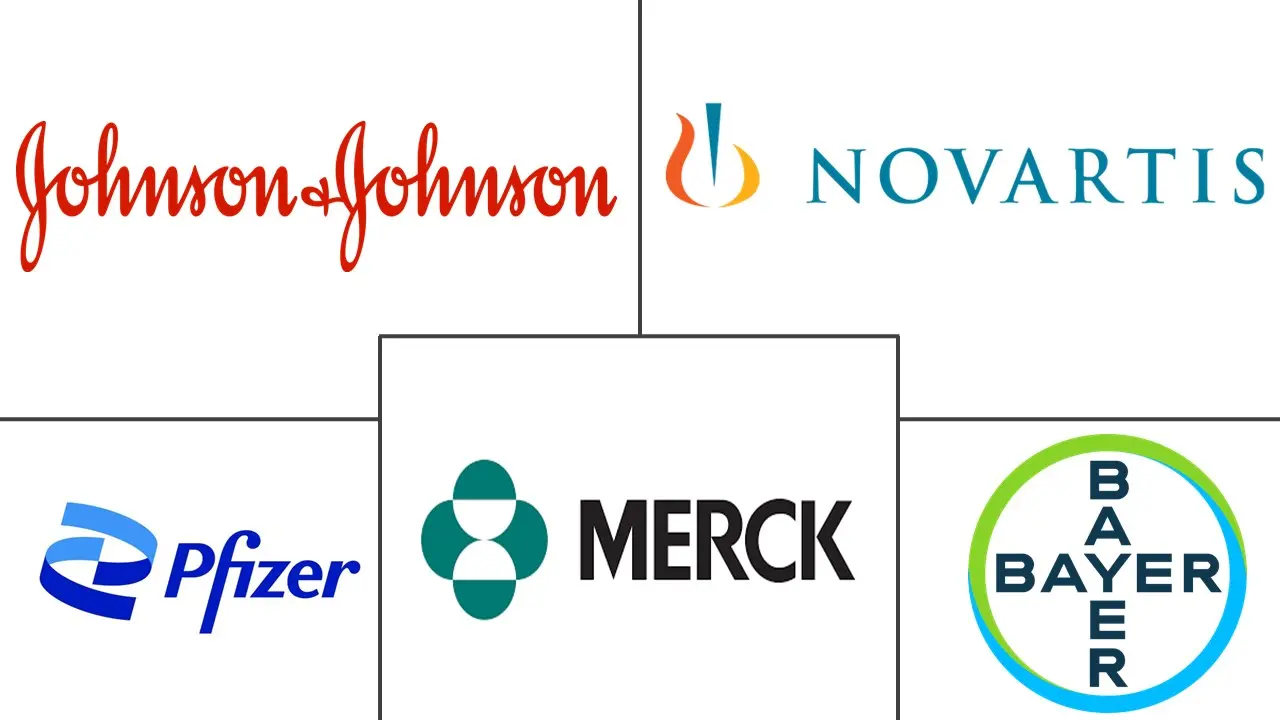Antihistamine Market Size and Share
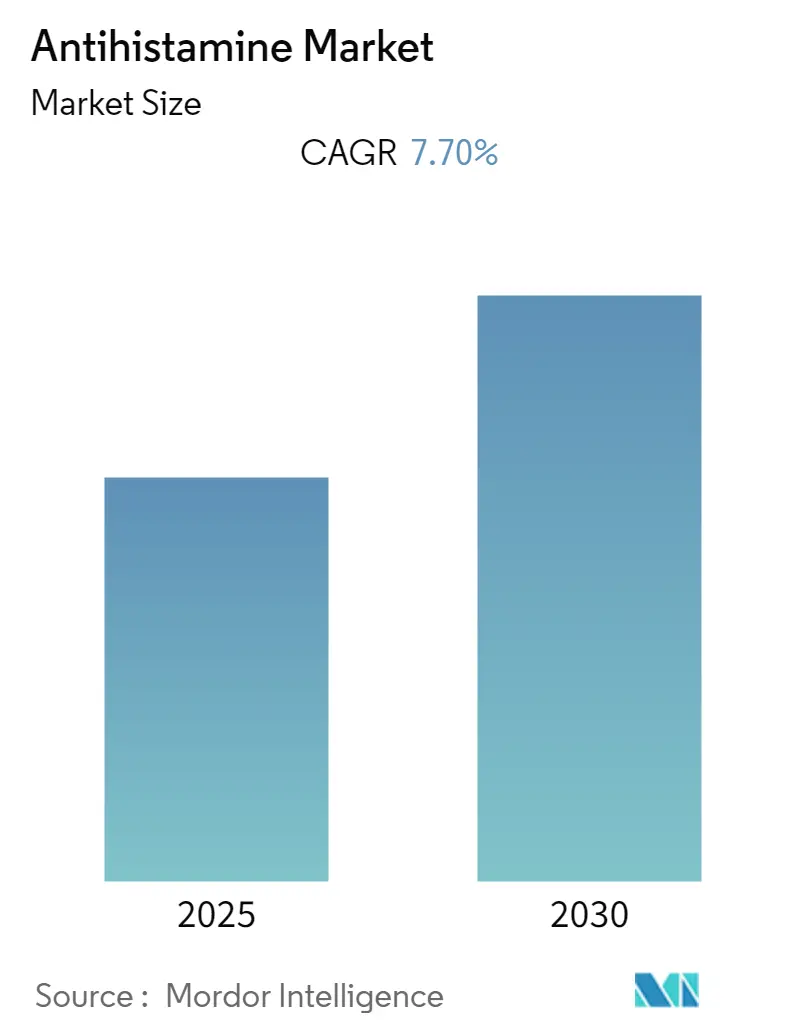
Antihistamine Market Analysis by Mordor Intelligence
The Antihistamine Market is expected to register a CAGR of 7.7% during the forecast period.
The market’s growth is driven by factors like rising allergies and stomach disorders issues and increasing research and development activities for novel dosage forms. The rising burden of allergies and acid reflex are anticipated to drive the market's growth during the forecast period. For instance, according to the data published by the Asthma and Allergy Foundation of America in April 2024, nearly one-third of American adults and over a quarter of American children suffer from seasonal allergies, eczema, or food allergies each year.
According to a study published in Rawal Medical Journal in September 2022, the prevalence of gastroesophageal reflux disease (GERD) was found to be 18.1% to 27.8% in North America, 8.8% to 25.9% in Europe, 2.5% to 7.8% in East Asia, 8.7% to 33.1% in the Middle East, 11.6% in Australia, and 23% in South America. Therefore, such a massive prevalence of allergies and stomach disorders is anticipated to increase the demand for antihistamines, driving market growth.
Furthermore, companies’ strategic activities, such as collaborations and agreements in using antihistamine medications, are anticipated to bolster market growth during the forecast period. For instance, in March 2023, Astepro Allergy partnered with Meghann Fahy to help patients suffering from allergies. Astepro is a long-lasting nasal spray that starts working in 30 minutes and can relieve allergy symptoms quickly. Therefore, such partnerships increase the usage of antihistamines, which is anticipated to increase their adoption among people and drive market growth.
Therefore, the rising issues of allergies and stomach disorders and the company's strategic activities are anticipated to drive market growth. However, the patent expiry of branded drugs, the introduction of generic drugs, and the adverse effects associated with antihistamine drugs are impeding market growth.
Global Antihistamine Market Trends and Insights
Allergic Disorders Anticipated to Hold a Significant Share in the Market Studied
The allergic disorders segment is anticipated to hold a significant market share due to the rising adoption of antihistaminics in allergic conditions. In people with allergies, the body interprets allergens such as pollen, pet hair, or household dust as a threat and releases histamine. Histamine triggers an allergic reaction that manifests as itchy, watery eyes, runny or stuffy nose, sneezing, and skin rashes.
Rising initiatives from key market players, such as the launch of allergic antihistamine products, are anticipated to drive the segment growth. For instance, in July 2022, Dr. Reddy’s Laboratories Ltd launched the over-the-counter (OTC) Fexofenadine HCl 180 mg and Pseudoephedrine HCl 240 mg extended-release tablets in the United States. Therefore, launching OTC antihistamine drugs for allergies is expected to lead to increased adoption, driving segment growth.
Furthermore, the efficacy of antihistamines in treating allergies is anticipated to drive the segment's growth further. For instance, according to a study published in the Brazilian Journal of Otorhinolaryngology in June 2023, oral H1 antihistamines were the first-line therapy for patients with allergic rhinitis, and rupatadine, an antihistamine, was considered the most effective in alleviating symptoms of patients with allergic rhinitis. Therefore, the importance of antihistamine drugs in treating allergies is expected to raise the demand for the segment.
Therefore, rising initiatives from key market players, along with the high importance of antihistaminic drugs in treating allergies, are factors anticipated to show lucrative growth in this segment.
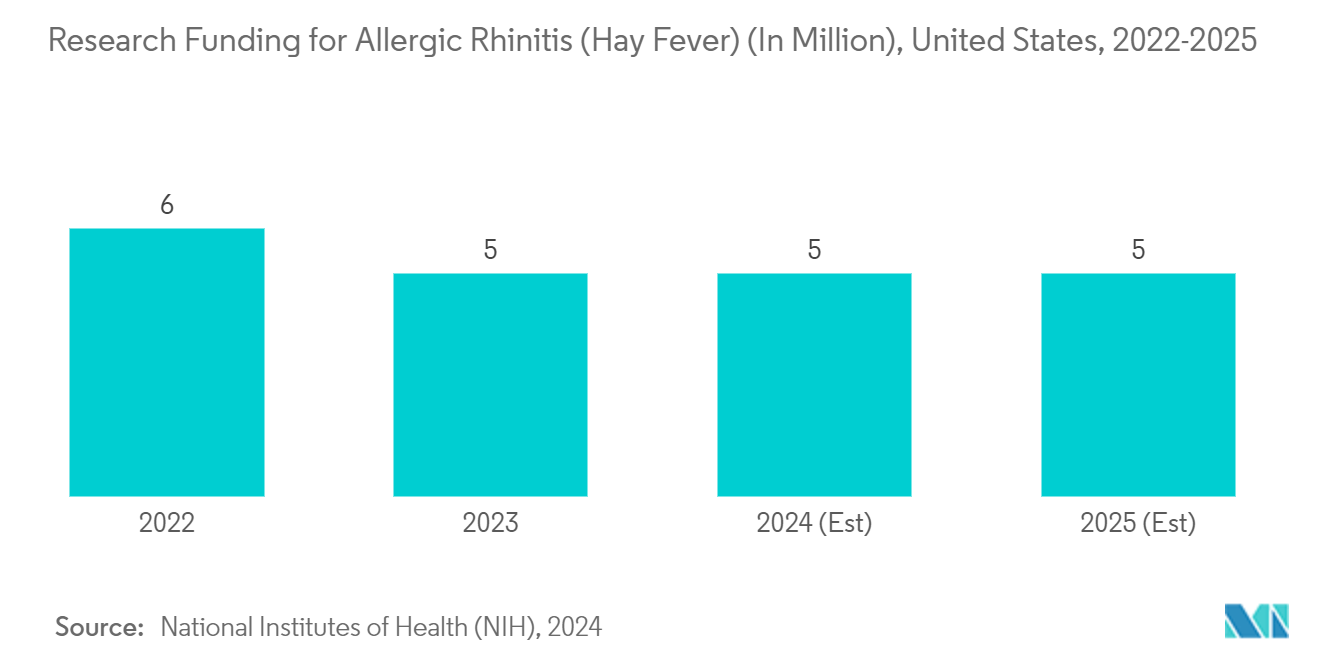
North America is Expected to Hold a Significant Share in the Market Over the Forecast Period
North America is anticipated to hold a significant share of the market studied due to the rising incidence of allergies, the strong foothold of key market players, improved healthcare infrastructure, medicare policies, and government funding for research and development of allergic disorders.
The rising prevalence of allergies is anticipated to drive the region's antihistamine market’s growth. For instance, according to the data published by the Centers for Disease Control and Prevention (CDC) in March 2024, around 60 million people in the United States are affected by allergic rhinitis symptoms annually. In addition, according to data published by the government of Canada in May 2024, more than 3 million people in Canada have food allergies. Such a massive prevalence of allergies in the region is anticipated to increase the demand for antihistamines to treat allergies, driving market growth.
In addition, the rising initiatives from key market players and approvals of antihistamine medications by national governments in the region are anticipated to boost market growth. For instance, in May 2023, in Canada, Bausch Health Companies Inc. launched its new prescription treatment, RYALTRIS (olopatadine hydrochloride and mometasone furoate nasal spray). This product is specifically used for the symptomatic treatment of moderate to severe seasonal allergic rhinitis (SAR).
Furthermore, increasing funds for researching and developing allergic conditions are expected to propel market growth. For instance, according to the National Institute of Health data updated in May 2024, research funding for food allergies was USD 77 million in 2022 and was estimated to reach USD 87 million by 2025. Hence, the increasing research funding helps develop new antihistamine therapy, which is anticipated to drive market growth during the forecast period.
Therefore, the above factors, such as rising allergy conditions, research funding, and initiatives from the key market players, are anticipated to drive market growth in the region.
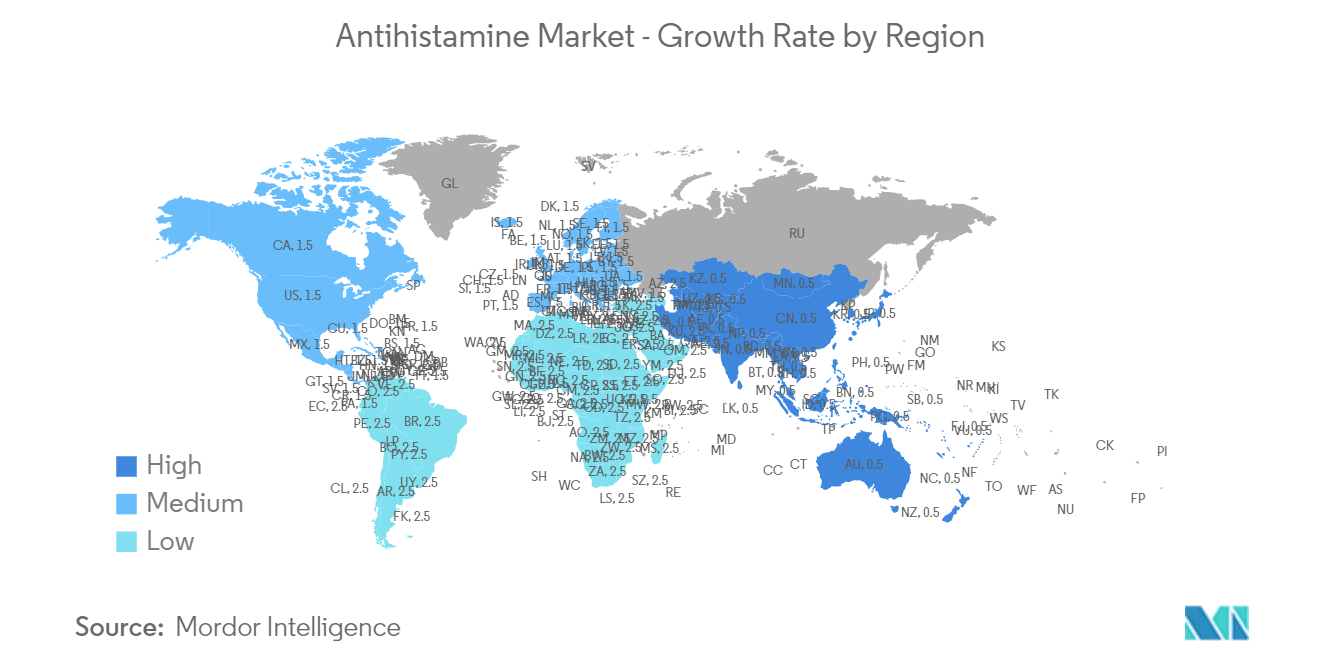
Competitive Landscape
The antihistamine market is fragmented, with several players holding a global market share. Factors owing to the competition include rising initiatives from the market players, such as launches and partnerships, and rising approvals of antihistamines, among others. Some of the players operating in the market include Johnson and Johnson, Novartis AG, Pfizer Inc., Merck and Co., Bayer AG, GSK, Almirall, and Akorn.
Antihistamine Industry Leaders
-
Johnson and Johnson
-
Novartis
-
Pfizer
-
Merck and Co.
-
Bayer
- *Disclaimer: Major Players sorted in no particular order
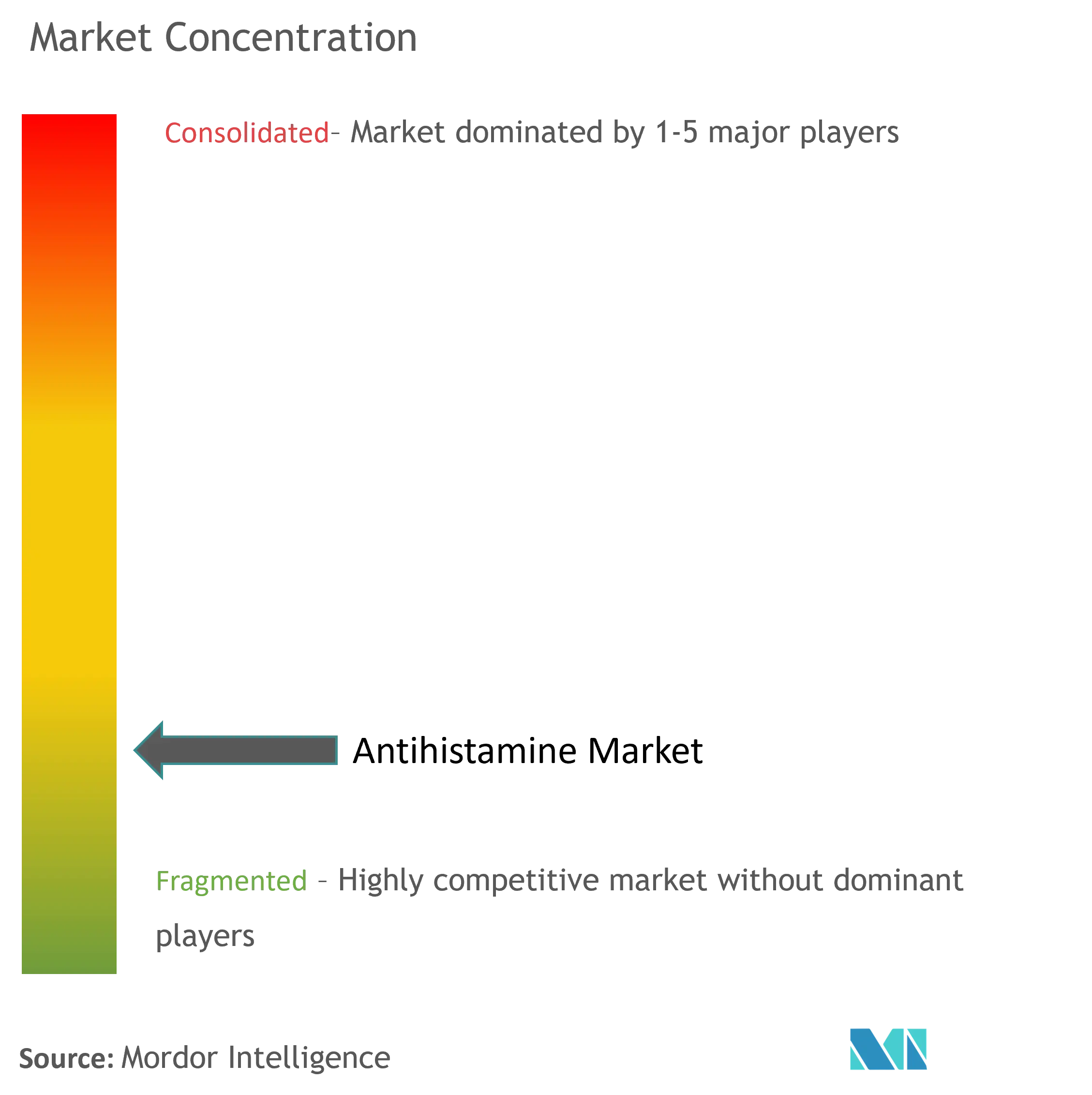
Recent Industry Developments
- January 2024: Dr. Reddy’s Laboratories (UK) Ltd launched its new allergy medication, Histallay (fexofenadine hydrochloride), in the UK general sales list (GSL) market.
- April 2023: Ocumension Therapeutics, an exclusive Chinese partner of Nicox SA, submitted a new drug application (NDA) for approval to commercialize Zerviate (cetirizine ophthalmic solution) 0.24% in China for ocular itching associated with allergic conjunctivitis. The product is expected to be launched in China in 2024.
Global Antihistamine Market Report Scope
As per the report's scope, antihistamines, a common medication class, are primarily employed to alleviate allergy symptoms. They combat conditions triggered by the body's overproduction of histamine, an immune system byproduct. Predominantly, antihistamines cater to individuals grappling with allergic responses to pollen and other allergens. Beyond allergies, they find utility in managing a spectrum of conditions, spanning from anxiety and colds to gastrointestinal maladies.
The antihistamine market is segmented by drug class, dosage form, type, disease, distribution channels, and geography. By drug class, the market is segmented into H1 antihistamines, H2 antihistamines, and H3 antihistamines. The H1 antihistamines segment is sub-segmented into first-generation and second-generation. By dosage form, the market is segmented into oral route, parenteral route, and other dosage forms. By type, the market is segmented into OTC and prescription-based. By disease, the market is segmented into allergic disorders, stomach disorders, central nervous system disorders, and other diseases. By distribution channels, the market is segmented into hospital pharmacies, retail pharmacies, and online pharmacies. By geography, the market is segmented into North America, Europe, Asia-Pacific, Middle East and Africa, and South America. The market report also covers the estimated market sizes and trends for 17 countries across major global regions. The report offers the value (USD) for the above segments.
| H1 Antihistamanics | First Generation |
| Second Generation | |
| H2 Anti histamanics | |
| H3 Anti histamanics |
| Oral route |
| Parenteral |
| Other Dosage Forms |
| OTC |
| Prescription-based |
| Allergic Disorders |
| Stomach Disorders |
| Central Nervous System Disorders |
| Other Diseases |
| Hospital Pharmacies |
| Retail Pharmacies |
| Online Pharmacies |
| North America | United States |
| Canada | |
| Mexico | |
| Europe | Germany |
| United Kingdom | |
| France | |
| Italy | |
| Spain | |
| Rest of Europe | |
| Asia-Pacific | China |
| Japan | |
| India | |
| Australia | |
| South Korea | |
| Rest of Asia-Pacific | |
| Middle East and Africa | GCC |
| South Africa | |
| Rest of Middle East and Africa | |
| South America | Brazil |
| Argentina | |
| Rest of South America |
| By Drug Class | H1 Antihistamanics | First Generation |
| Second Generation | ||
| H2 Anti histamanics | ||
| H3 Anti histamanics | ||
| By Dosage Form | Oral route | |
| Parenteral | ||
| Other Dosage Forms | ||
| By Type | OTC | |
| Prescription-based | ||
| By Disease | Allergic Disorders | |
| Stomach Disorders | ||
| Central Nervous System Disorders | ||
| Other Diseases | ||
| By Distribution Channels | Hospital Pharmacies | |
| Retail Pharmacies | ||
| Online Pharmacies | ||
| By Geography | North America | United States |
| Canada | ||
| Mexico | ||
| Europe | Germany | |
| United Kingdom | ||
| France | ||
| Italy | ||
| Spain | ||
| Rest of Europe | ||
| Asia-Pacific | China | |
| Japan | ||
| India | ||
| Australia | ||
| South Korea | ||
| Rest of Asia-Pacific | ||
| Middle East and Africa | GCC | |
| South Africa | ||
| Rest of Middle East and Africa | ||
| South America | Brazil | |
| Argentina | ||
| Rest of South America | ||
Key Questions Answered in the Report
What is the current Antihistamine Market size?
The Antihistamine Market is projected to register a CAGR of 7.70% during the forecast period (2025-2030)
Who are the key players in Antihistamine Market?
Johnson and Johnson, Novartis, Pfizer, Merck and Co. and Bayer are the major companies operating in the Antihistamine Market.
Which is the fastest growing region in Antihistamine Market?
Asia Pacific is estimated to grow at the highest CAGR over the forecast period (2025-2030).
Which region has the biggest share in Antihistamine Market?
In 2025, the North America accounts for the largest market share in Antihistamine Market.
What years does this Antihistamine Market cover?
The report covers the Antihistamine Market historical market size for years: 2019, 2020, 2021, 2022, 2023 and 2024. The report also forecasts the Antihistamine Market size for years: 2025, 2026, 2027, 2028, 2029 and 2030.
Page last updated on:
Antihistamine Market Report
Statistics for the 2025 Antihistamine market share, size and revenue growth rate, created by Mordor Intelligence™ Industry Reports. Antihistamine analysis includes a market forecast outlook for 2025 to 2030 and historical overview. Get a sample of this industry analysis as a free report PDF download.
